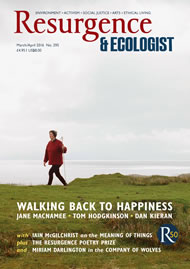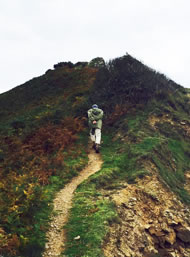Walking is a metaphor as well as an act. When we walk our talk, we integrate the ideal with the reality; we bring principles into practice. It was Nietzsche who said: “All truly great thoughts are conceived while walking.”
There is an implicit connection between such thought and the school of peripatetic philosophers. Theologians have their cloisters around a monastic courtyard, and churches and cathedrals have sacred space around them for walking while studying and meditating on the mysteries of faith and the metaphysics of existence. Pilgrims go on foot on sacred journeys to reach their divine destinations. They walk around the holy peaks of the Himalayas, or to the confluence of sacred rivers, or to the places associated with prophets, poets and mystics. The act of walking in itself is as meaningful for pilgrims as the fact of arrival.
Environmental, social and political activists walk in protest against the pollution, exploitation and injustice perpetuated by those who hold the reins of power. Mahatma Gandhi’s Salt March to the sea and the March on Washington during which Martin Luther King, Jr. delivered his “I have a dream” speech, were acts of political defiance as well as spiritual awakening. Millions of men and women have walked to bring an end to colonialism, racialism, sexism, capitalism, communism and militarism. As mothers with their babies in prams and disabled radicals in their wheelchairs have walked to show their solidarity with the poor and the oppressed, cultural creatives of all ages, nationalities and political persuasions have walked to proclaim their support for sustainability, spirituality, justice, peace, freedom, human rights and the rights of the Earth.
My teacher and mentor Vinoba Bhave walked more than 100,000 miles the length and breadth of India over 15 years persuading wealthy landlords to share their land with landless labourers in the name of justice. It was a miracle that he was able to open the hearts of these landowners and collect 4 million acres of land in gifts, which he distributed among dispossessed and deprived people. It was his walk that inspired and impressed wealthy people to part with their land.
My mother was a great walker, too. She had a smallholding about an hour’s walk from our house in Rajasthan. She would always go on foot to reach the farm. Our family was blessed with a horse and a camel, but Mother never rode on animals. Our religious tradition, Jainism, required us to respect animals and not inflict any undue suffering or hardship upon them. If someone suggested to my mother that she ride on a horse, she would smile and simply reply: “How would you like it if the horse wanted to ride on you?”
So walking came to me without any effort. I would walk with my mother to the farm or wherever she went. She told stories and sang songs while walking. She observed the miracles of Nature that most people took for granted. Walking, for my mother, was a source of joy and pleasure.
And so it is for me. In my early childhood I became a Jain monk. I walked barefoot for nine years, never even touching a car, a train, a plane or a boat – not even a bicycle. My feet became wide and firm. I walked on sand, on pebbles, in heat and in cold, without socks, sandals or shoes. And yet in my mind I thought that I was walking on rose petals. My guru said to me: “Practise gratitude towards the Earth who holds you on her back and enables you to walk.” This was his way of teaching me a lesson in Earth spirituality. “People plough the Earth, they tread upon her, dig holes in her body, and yet the Earth forgives. She is so generous that you plant one seed and she returns a thousand fruits. So meditate on the unconditional love of the Earth and practise the same kind of compassion, generosity and forgiveness in your own life.”
I parted company with the monastic order of the Jains, but not with my love of walking. So when in the early 1960s the idea came to me that I with my friend E.P. Menon should walk from New Delhi to Moscow, Paris, London and Washington, I jumped at it without a moment’s hesitation. We dedicated our walk to the cause of Peace and walked 8,000 miles without a penny in our pockets. Whether we were able to bring more peace to the world or not, I certainly found peace within myself through walking.
I learned to trust myself, to trust strangers and to trust the world. I gained confidence and resilience. I was able to drop the fear of the unknown, the unplanned and the uncertain. I managed to love mountains, forests and deserts equally. I appreciated wind and rain, snow and sunshine with equanimity. I faced hostility and hospitality with humour and acceptance. I learned to expect nothing and accept everything as it comes. When there is no expectation, there is no disappointment. Walking for me became a source of self-realisation. Now walking is more than a way to move from A to B: it is a way of life; a way to health, harmony and happiness.
When I was 50 I went on a pilgrimage around the British Isles. From Devon to Somerset and Dorset and then on to the Pilgrims’ Way to Canterbury, I walked from village to village and from town to town, immersing myself in the beauty of the British landscape. Then along the east coast I arrived at the holy isle of Lindisfarne, where the Celtic saints of ancient times meditated on Nature while standing in the sea.
I walked across Scotland and reached Iona, one of the most peaceful places I have ever been to, then along the west coast down to Wales and back through the West Country, over Exmoor and home to Hartland. It was a journey over four months and 2,000 miles, where I enjoyed hospitality from people of all backgrounds. I walked without any money in my pocket and encountered many miracles emerging out of the sheer generosity and goodness of ordinary men and women whom I met – many for the first time – during that journey.
I am 80 this year. Thanks to walking, I lack no energy, enthusiasm or passion. I have never taken any form of antibiotics and have never been hospitalised, with one single exception: when I broke my ankle while making the Earth Pilgrim film for the BBC.
People ask me: “What is the secret of your good health?” My answer is plain and simple. I just use one word: “Walking.” It is good for my body, good for my mind and good for my spirit. I walk for an hour or so every day, and failing that I go for a constitutional stroll after my meal. Walking is digestive, refreshing and calming. No words are sufficient to contain my praise for walking. I choose to move and flow rather than to remain fixed and static.
A NEW PILGRIMAGE
This year marks the 50th anniversary of Resurgence magazine. To celebrate, I plan to walk with friends the 50 miles from the source of the river Thames, near Cirencester, to Oxford. The journey will begin on the morning of the 17 September and end on the 21st. From 22–25 September there will be a 50th-anniversary celebration at Worcester College, Oxford. A detailed programme of events will be published in the May/June issue of Resurgence & Ecologist and on our website.








